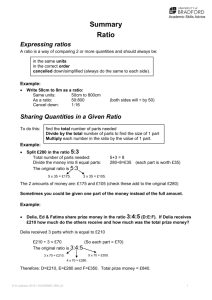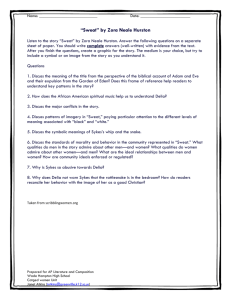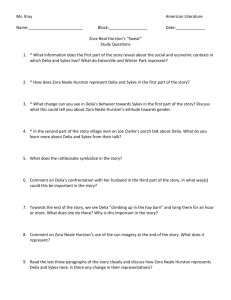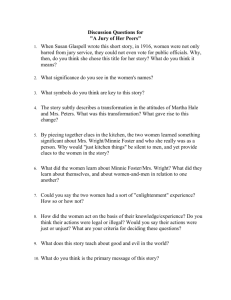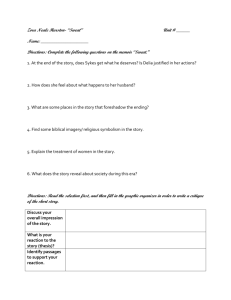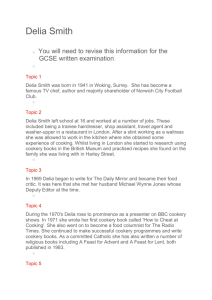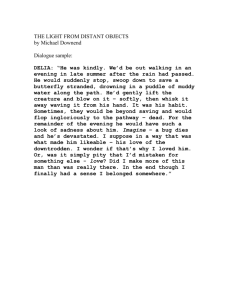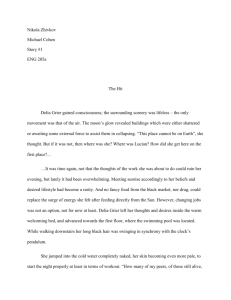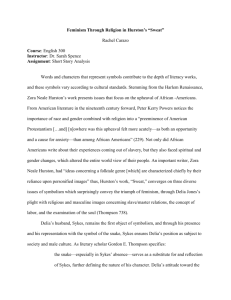A Jury of Her Peers – written 1917
advertisement
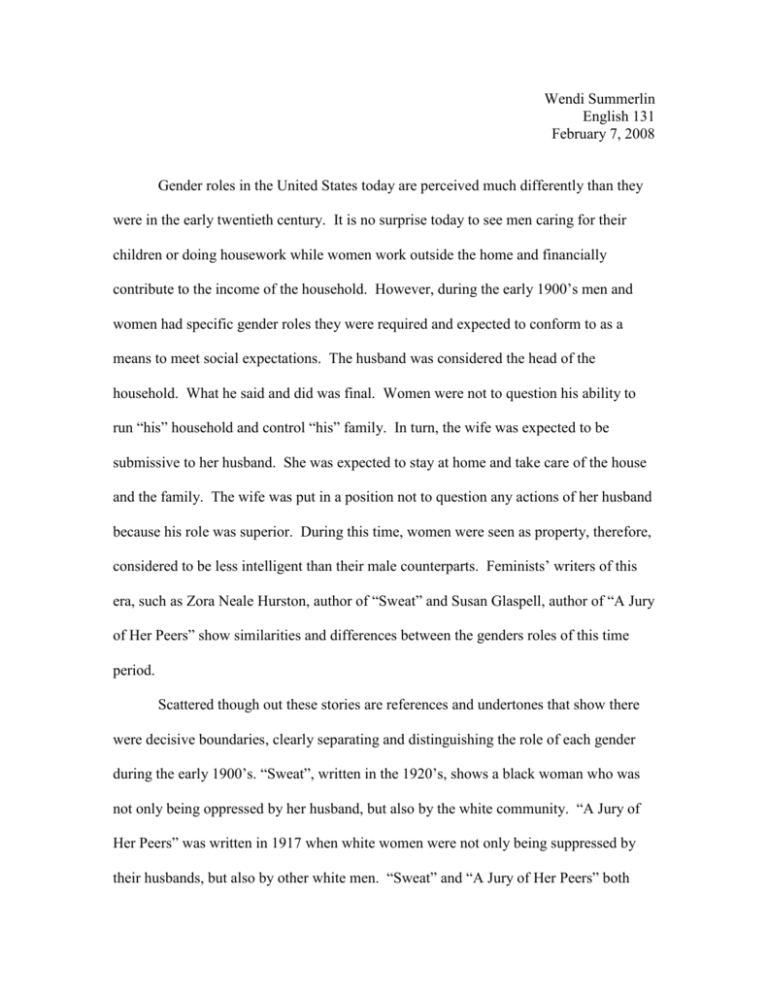
Wendi Summerlin English 131 February 7, 2008 Gender roles in the United States today are perceived much differently than they were in the early twentieth century. It is no surprise today to see men caring for their children or doing housework while women work outside the home and financially contribute to the income of the household. However, during the early 1900’s men and women had specific gender roles they were required and expected to conform to as a means to meet social expectations. The husband was considered the head of the household. What he said and did was final. Women were not to question his ability to run “his” household and control “his” family. In turn, the wife was expected to be submissive to her husband. She was expected to stay at home and take care of the house and the family. The wife was put in a position not to question any actions of her husband because his role was superior. During this time, women were seen as property, therefore, considered to be less intelligent than their male counterparts. Feminists’ writers of this era, such as Zora Neale Hurston, author of “Sweat” and Susan Glaspell, author of “A Jury of Her Peers” show similarities and differences between the genders roles of this time period. Scattered though out these stories are references and undertones that show there were decisive boundaries, clearly separating and distinguishing the role of each gender during the early 1900’s. “Sweat”, written in the 1920’s, shows a black woman who was not only being oppressed by her husband, but also by the white community. “A Jury of Her Peers” was written in 1917 when white women were not only being suppressed by their husbands, but also by other white men. “Sweat” and “A Jury of Her Peers” both show how these women, though from two totally different worlds, were made to feel unimportant and be considered of lesser value because they were not male. Both of these women were beat and broken down by their husbands and society. One woman’s abuse was more public because the community saw what was happening to her, while the other woman basically suffered in silence because no one in the community ever saw her in public or went to visited her on the farm. However, at the end of both stories all the women involved were underestimated by their husbands and other men, which enabled them to take control of the situation and dictate the final outcome of the story. In the story “Sweat” a black woman by the name of Delia Jones is a hard working woman trying to provide a good life for her family. However, her husband Sykes is abusive. He constantly uses his actions and words to show Delia that he is in control of her. Sykes regularly degrades, humiliates, and beats Delia basically because he can. He states “Don’t gimme no lip neither, else Ah’ll throw’em out and put mah fist up side yo’head to boot” (Hurston). People in the community know about the torment and suffering Delia is living with as shown through the conversation between other black men. The comment of “He done beat huh ‘nough tuh kill three women” (Hurston) is made but they do nothing to help or protect her from Sykes. As a woman during this time, Delia has no rights. She must accept her situation and take the abuse from her husband. Delia is forced to stay in an unhappy marriage because if she leaves she will loose everything she has worked so hard for over the past fifteen years. This includes purchasing tangible items for their home which her husband cares nothing about. However, according to society during this time it did not matter if the woman had worked and bought items for the home because everything belonged to the husband. If Delia decides to leave her home, she would have to leave with nothing. One day when Sykes starts with a reign of terror, Delia stands up to him. Even though she is much smaller, she decides she has taken enough abuse from her husband. Delia protects herself from a severe beating by seizing “the iron skillet from the stove and struck a defensive pose, which act surprised him greatly, coming from her” (Hurston). In an effort to show Delia he is in charge, Sykes brings home a snake to keep in the house. He knows Delia is terrified of snakes so he uses it as a scare tactic in an effort to show his wife he is in control of her and her life. After the initial shock Delia learns to deal with the snake even though she is afraid. She keeps faith that one day things will be different “Oh well, whatever goes over the Devil’s back, is got to come under his belly. Sometime or ruther, Sykes, like everybody else, is gointer reap his sowing (Hurston). Eventually that time does come when Delia has a chance to make the choice to either save her husband’s life or let him die. She thinks about all the years of sacrifice, torment, and oppression she has suffered while being married to this man. Delia chooses to do nothing. She saves herself and lets him die. “A Jury of Her Peers” is about a white woman named Minnie Wright who is thought to have strangled her husband John to death with a rope while he slept. Not many people in the community knew John Wright very well. Basically he was considered a good man “He didn’t drink, and kept his word as well as most, I guess, and paid his debts. But he was a hard man” (Glasspell). After the murder Minnie is being held in jail while the sheriff tries to figure out what has happened. Two women from the community, a neighbor and the sheriff’s wife, go to the house during the investigation to get Minnie some clothes. The men are looking for clues, but in their minds what they see is not a clue to the murder it is just poor housekeeping on the part of the wife. The sheriff makes several comments about how Minnie was not a good housekeeper because the house seems to be in such disarray “Dirty towels! Not much of a housekeeper, would you say ladies?” (Glaspell). The men tell the women to look for clues but they do not expect them to find anything because they are women “But would the women know a clue if they did come upon it?” (Glaspell). However, the women do see many clues inside the house that the men do not see. These women know exactly how a woman is taught to keep a house and this was not it. They felt bad Minnie was being judged by the men without them even knowing her or her family situation “I’d hate to have men comin’into my kitchen snoopin’round and criticizing” (Glaspell) By taking the time to look at the smallest of details the women can see signs of mistreatment, loneliness, and an unhappy marriage. What the women were seeing would explain why the house was in such disarray. The sheriff and the other men are only looking for obvious clues around the house to connect Minnie with the murder or find the intruder. They were looking for such things as a murder weapon or some sign of a home invasion. None of the men are taking the time to look carefully at the details inside and outside the house that might help them understand the private life of John and Minnie Wright. The men were overlooking the signs of torment and abuse Minnie was receiving at the hands of her husband. The details such as dirty pans under the sink, dirty towels, the broken stove, broken furniture, old dresses that had been repaired many times, and finally the broken bird cage were all very important clues. The two women are able to talk through what they see and clearly understand the frame of mind Minnie Wright was in that night before her husband was killed. These women we able to admit they too had suffered from oppression in their past just like Minnie. So when they find a major clue that might be the evidence needed to convict Minnie, they hide it from the men in an effort to protect her. The men thought the women would not know a clue even if they found one, so the women just went on letting the men think what they wanted to. During the early twentieth century all women whether they were white or black faced oppression from men. In society at that time, women in general had specific roles they were required and expected to conform to as a means to meet social expectations. The husband was to work outside the home and provide for the family, while the wife stayed at home and took care of the house and children. However, as the years passed women slowly began to realize they had just as many rights as men. More and more women began to exercise these rights in public and at home by voicing their opinions. Feminists’ writers Zora Neale Hurston, author of “Sweat” and Susan Glaspell, author of “A Jury of Her Peers” were able to bring to light the oppression of women during the early twentieth century within the context of their stories. As a result of this, society as a whole began to change their gender expectations. Unfortunately abuse is not a thing of the past, but now it is against the law. Women in the early twentieth century paved the way for the women of today and tomorrow. Now in the United States, women are not forced to adhere to specific gender roles as a means to meet social expectations. Today, women whether they are white or minority are considered valuable contributors to society. Their opinions and ideas are considered to be of just as much importance as any male. Women do not have to accept or tolerate oppression in their lives because now it is against the law.
